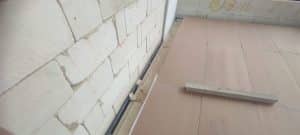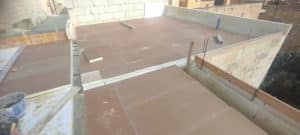Microcement has quickly gained popularity in Malta and across Europe for its seamless finish, minimalist appeal, and unmatched versatility. It’s a go-to material for bathrooms, kitchens, floors, walls, pools, and even furniture. But with its rise in popularity, some homeowners and construction professionals alike have raised a vital question: is microcement toxic?
The short and comforting answer? No, it is not. In fact, high-quality microcement is made with eco-friendly materials that are safe for humans, pets, and the environment. But let’s not stop there—below, we’ll dive deep into seven eye-opening truths about microcement, toxicity, safety, and environmental impact to help you make an informed decision.
1. What Is Microcement Made Of?| Is Microcement Toxic
To understand whether microcement is toxic, it’s important to look at what it’s made of. Microcement is a composite coating material composed of:
Cement
Water-based resins
Mineral pigments
Additives
None of these components are inherently toxic when handled and applied correctly. The resins used are typically water-based, which significantly reduces the presence of volatile organic compounds (VOCs)—the main culprits when it comes to toxic construction materials.
2. VOCs: The Real Danger in Some Coatings| Is Microcement Toxic
Volatile Organic Compounds (VOCs) are chemicals that easily evaporate at room temperature and are often found in paints, sealants, and coatings. High levels of VOCs can cause health issues like headaches, dizziness, and respiratory problems.
When asking, “is microcement toxic?”, the VOC content is often what people are really concerned about. Fortunately, premium microcement brands used in Malta and across Europe follow strict EU regulations that limit VOC content. In most cases, microcement has VOC levels well below the threshold, making it a safe option for indoor use.
3. Safe for Residential and Commercial Use| Is Microcement Toxic
Microcement is widely used in both homes and commercial spaces because it’s considered non-toxic once cured. This means that once the product has fully dried and hardened (usually within 24-72 hours), it emits no harmful gases or substances. That makes it perfectly safe for:
Children’s rooms
Pet-friendly homes
Restaurants and kitchens
Healthcare facilities
Its non-toxic nature is part of what makes microcement such a versatile and widely approved surface material in the construction industry.
4. Is Microcement Toxic During Installation?| Is Microcement Toxic
During application, microcement is mixed and layered in several coats. The process is dust-free and fume-free if you’re using high-quality, certified products. Installers should still wear protective gear—not because of toxicity, but to avoid skin irritation from cement or prolonged contact with wet materials.
Here’s a quick comparison:
| Material | Toxic Fumes During Install? | Safe After Curing? |
|---|---|---|
| Traditional Paint | Yes (High VOCs) | Mostly |
| Epoxy Resin | Yes | Depends on brand |
| Microcement | No | Yes |
So, if you’re worried about breathing in something harmful while microcement is being applied—don’t be. Just keep the area ventilated, and you’re good to go.
5. Eco-Friendly and Sustainable Option| Is Microcement Toxic
If you care about reducing your environmental footprint, you’ll be pleased to know that microcement is a highly sustainable material. Why?
It’s long-lasting (up to 20 years or more with proper maintenance)
Requires no demolition (applied over existing surfaces like tiles or concrete)
Uses low-energy materials
Contains water-based, non-toxic ingredients
By reducing the need for tile waste and heavy demolition, microcement contributes to greener building practices.
Plus, some microcement brands offer certified eco-labels, giving you added assurance about environmental responsibility.
6. Anti-Bacterial and Hypoallergenic Properties| Is Microcement Toxic
Another common concern when people ask “is microcement toxic?” is whether it harbors bacteria or triggers allergies. The answer again is reassuring.
Microcement is:
Seamless: No grout lines where bacteria or mold can hide
Non-porous: When sealed properly, it resists moisture and prevents bacterial growth
Hypoallergenic: No allergens, fibers, or dust-trapping surfaces
That makes it perfect for households in Malta where humidity can be an issue, especially in bathrooms or near the coast.
7. What About Kids and Pets?| Is Microcement Toxic
This is perhaps the most relatable concern. If you have small children crawling on floors or pets licking surfaces, you absolutely want to be sure the materials in your home are safe.
Microcement meets EU safety standards and is non-toxic once applied. It won’t emit harmful gases or leave residues. Also, because it’s durable and resistant to scratches, it holds up well in active households.
Many parents and pet owners in Malta choose microcement for:
Playrooms
Pet areas
Nurseries
Kitchen floors
So, Is Microcement Toxic? Absolutely Not.| Is Microcement Toxic
To wrap up this first part of the discussion: microcement is not toxic. It’s one of the safest and most eco-conscious surface finishes available today. With no harmful emissions, VOCs, or post-installation dangers, it’s a top-tier choice for anyone concerned about indoor air quality or environmental impact.
And the best part? It looks stunning and lasts for years.
You can also contact us to purchase microcement products or book professional installation services in Malta at https://kibitec.com/contact-us/.
4. Comparing Microcement to Other Materials: Toxicity & Health Impacts| Is Microcement Toxic
When evaluating whether a material is toxic, it’s important to compare it with traditional alternatives like tiles, paint, concrete, and epoxy.
Traditional Concrete: Regular concrete contains Portland cement and aggregates, and though not inherently toxic, the dust generated during mixing and sanding can cause respiratory issues.
Tiles & Adhesives: Ceramic and porcelain tiles themselves are generally non-toxic, but the adhesives, grouts, and sealants used often contain VOCs (volatile organic compounds), especially when cheap products are used.
Epoxy Coatings: Many epoxy flooring systems emit strong chemical odors and are made with petroleum-based resins. These can release harmful compounds, especially during application.
Painted Surfaces: Even many so-called low-VOC paints can release small amounts of chemicals into the air over time, impacting indoor air quality.
By contrast, microcement stands out as a safe, non-toxic solution. Premium-quality microcement products, like those used by Kibitec in Malta, are formulated with natural minerals and water-based resins, ensuring a safer environment.
5. Microcement in Sensitive Spaces: Safe for Children, Pets, and Hospitals| Is Microcement Toxic
One of the most powerful arguments in favor of microcement’s non-toxic nature is its widespread use in areas where safety and hygiene are paramount:
Children’s Bedrooms & Play Areas: Because it doesn’t release VOCs or harmful particles, microcement is perfectly safe for babies, toddlers, and kids. Plus, it’s hypoallergenic—great news for sensitive little lungs.
Pet Areas: Non-toxic, seamless, and easy to clean, microcement floors are ideal for pet-friendly homes. They won’t trap fur or odors.
Hospitals & Clinics: Microcement’s hygienic and non-toxic qualities have made it a popular choice in the healthcare sector. It meets EU safety and hygiene regulations without needing harsh chemical sealers or coatings.
Commercial Kitchens & Restaurants: Food-grade safe microcement coatings can be used in food preparation zones due to their non-toxic formulation and easy maintenance.
All of this supports the answer to our main question: is microcement toxic? Absolutely not!
6. Eco-Friendly and Sustainable Construction Practices| Is Microcement Toxic
In today’s age, building sustainably is more than a trend—it’s a responsibility. Microcement is often preferred in green construction projects due to its eco-friendly profile.
Here’s why microcement is ideal for those pursuing environmentally conscious designs:
Minimal Waste: Unlike tiles that generate offcuts or epoxy resins that involve single-use containers, microcement uses only the amount needed, reducing landfill.
Low Embodied Energy: Since it can be applied thinly (2-3mm), less material is used compared to thicker alternatives like concrete.
Long Life Span: Microcement can last for decades without cracking, chipping, or fading—meaning fewer replacements and less consumption.
No Demolition Needed: It can be applied directly on top of tiles, concrete, or wood, reducing demolition waste and saving both time and money.
In Malta, this aligns with national goals to build greener and more sustainable homes and commercial spaces.
7. Cost of Non-Toxic Microcement in Malta| Is Microcement Toxic
Microcement’s eco-friendly, non-toxic profile might make it sound expensive, but in reality, it is competitively priced compared to alternatives.
Base Price: Expect to pay around €65 to €90 per square metre for supply and application.
Eco-Certified Microcement Products: Higher-end options that are 100% eco-certified may cost up to €100/m², but you’re getting guaranteed safety, durability, and sustainability.
In return, you get a beautiful, safe, toxin-free surface that can be used throughout your home or commercial space—walls, floors, bathrooms, kitchens, and more.
Final Thoughts: Is Microcement Toxic?| Is Microcement Toxic
To wrap things up clearly: is microcement toxic? No, it’s not. In fact, when sourced from reputable providers like Kibitec and applied by professionals, it’s among the safest and most environmentally friendly finishing materials available in Malta.
Whether you’re renovating a home, upgrading a retail space, or designing a wellness clinic, microcement offers peace of mind. No VOCs. No harmful chemicals. Just a sleek, stylish surface that’s safe for everyone.
Ready to Go Non-Toxic with Microcement?| Is Microcement Toxic
If you’re looking to embrace a safer, more sustainable material for your renovation or new build in Malta, microcement is your go-to choice.
💬 Have questions? Want a quote? Need expert advice? Contact us today and let Kibitec guide you through your microcement journey.




